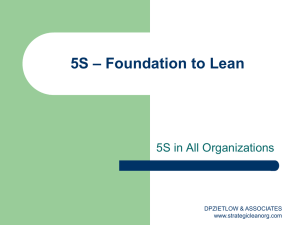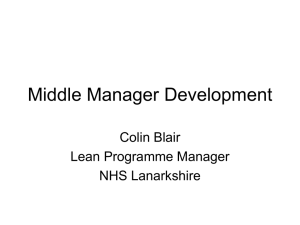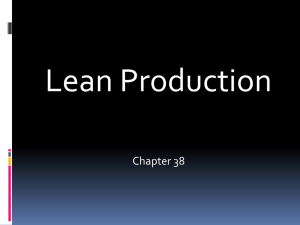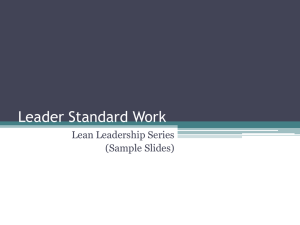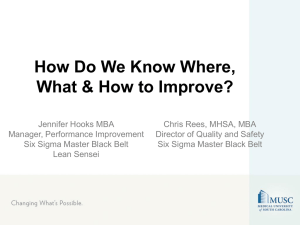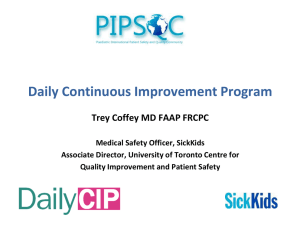Lean Culture
advertisement
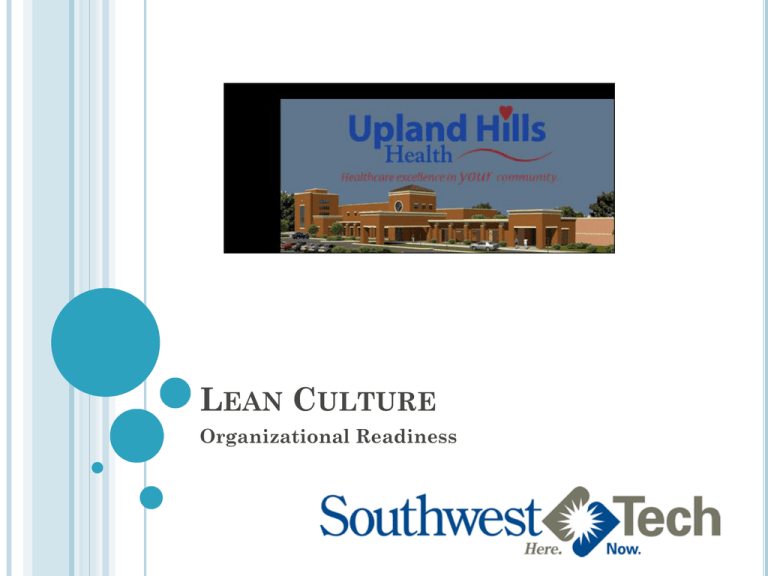
LEAN CULTURE Organizational Readiness YOUR TIME TO RELAX WHAT IS ORGANIZATIONAL CULTURE? “The sum of habits people rely on to get things done. Culture also sums up things a member of a work group needs to know to comply with in order not to be seen as deviant by other members”-Creating a Lean Culture by David Mann The way we do things around here! SHARE… What are some of the habits that describe your organization's culture? QUESTIONS THAT HELP TO DEFINE CULTURE What metrics tell task experts that they are meeting expectations? How often does management look at the status of work metrics? Who is involved in process-improvement activities in this area? What is the typical response when problems arise? WHY…. ….does culture need to change in a lean enterprise? Not because lean is so difficult but because lean is so different. CULTURES CONTRIBUTION TO LEAN TRADITIONAL VERSUS LEAN CULTURE: PRIMARY BUSINESS Traditional Product-centric strategy Focus on exploiting economies of scale of stable product or service Lean Customer-focused strategy Focus on identifying and exploiting shifts in competitive advantage TRADITIONAL VERSUS LEAN CULTURE: ORGANIZATIONAL STRUCTURE Traditional Hierarchical structure along functional lines Encourage functional alignments and following orders Inhibits information highlighting deviations Lean Flat, flexible organizations along line of value creation Encourages individual initiative Encourages flow of information that highlights deviations TRADITIONAL VERSUS LEAN CULTURE: OPERATIONAL FRAMEWORK Traditional Application of tools along division of labor Follow orders Few problemsolving skills Lean Application of tools assuming standardized work Strength in problem identification, hypothesis generation, and experimentation TRADITIONAL VERSUS LEAN CULTURE: WORK STATUS Traditional Checked at end of shift Checked by supervisor, higher level managers Scrutinized monthly Lean Checked by team leaders several times per hour Checked by supervisor four or more times per shift Checked by Value Stream Manager once or twice per shift All involved review previous day’s performance TRADITIONAL VERSUS LEAN CULTURE: PROCESS IMPROVEMENT Traditional Made by technical project teams Changes must be specifically “chartered” No changes between “official” projects Lean Routinely initiated by anybody, including task experts Regular, structured vehicle encourages both input and involvement Improvement occurs more or less all the time, continuously MASS VERSUS LEAN CULTURE: PROBLEM SOLVING Traditional Do whatever it takes to take care of today’s numbers Work around the problem; just meet the daily/weekly/monthly goals Lean Record immediate circumstances of the miss, interruption or breakdown Put temporary countermeasures in place Assign tasks to eliminate root cause of problems EVALUATE Which characteristic represents the greatest gap in your organization between current culture and lean culture? Working with partners identify specific actions that might be taken to close the gap. CULTURAL INERTIA “A body in motion tends to stay in motion” In what ways does culture tend to become self-sustaining within an organization? What happens to those in the organization not following the norms of the culture? What hints might this offer to changing culture? REMEMBER….. Just as a pig with lipstick is still a pig… ….an organization with a traditional culture using lean tools is still a traditional organization. QUESTIONS…. How many of you have quit smoking or another habit? How many of you have quit only once? Why were initial efforts defeated? CONSIDER…. The same is true in changing habits of a traditional organization: Breaking a habit implies sudden change, often with minimal or no support Extinguishing a habit implies planned, paced change with ongoing support, and a clear new habit to replace the old habit REMEMBER… …..when problems arise or when confronting the first sign of trouble people will revert to old habits. HABITS THAT ARE DIFFICULT TO EXTINGUISH Focus primarily on department efficiency and performance metrics. Look to lay blame or “find the guilty party” when errors occur or problems arise. Discuss performance metrics primarily with peers or “up” the organization. Require task experts to work within their job descriptions and strictly adhere to chain of command. Work around today’s problem and let tomorrow take care of itself. Leave improvement to experts instead of listening to task expert suggestions. SHARE…. What is the most difficult habit for your organization to extinguish? Why is this the case? What habit needs to replace it? How can change to new habit best be supported? DEFINING A LEAN CULTURE Maintaining an unrelenting focus on providing customer value Adopting a philosophy of continuous, incremental improvement Providing exactly what is needed at the right time, based on customer demand Keeping things moving (flow)-in a value-added effective manner Using techniques for reducing variation and waste Respecting people Lean Culture Taking the long-term view SHARE…. ….to what extent do these characteristics define your current culture? Lean Culture LEAN CULTURE Process Focus TRADITIONAL APPROACH Kahuna Manager A Manager B Manager C Manager D SYSTEMS APPROACH Kahuna Manager A Manager B Manager C Process A Process B Process C Manager D TRADITIONAL VERSUS LEAN FOCUS Traditional Independent “Leave me alone” “We do whatever it takes to get the job done, I know who to rely on in crunch time “I define my own methods” Lean TRADITIONAL VERSUS LEAN FOCUS (CONTINUED) Traditional Results are the focus, do what it takes Managed by the pay or bonus system Improvement is somebody else’s job, not mine Lean TRADITIONAL VERSUS LEAN FOCUS Traditional Independent “Leave me alone” “We do whatever it takes to get the job done, I know who to rely on in crunch time “I define my own methods” Lean TRADITIONAL VERSUS LEAN FOCUS Traditional Independent “Leave me alone” “We do whatever it takes to get the job done, I know who to rely on in crunch time “I define my own methods” Lean Interdependent TRADITIONAL VERSUS LEAN FOCUS Traditional Independent “Leave me alone” “We do whatever it takes to get the job done, I know who to rely on in crunch time “I define my own methods” Lean Interdependent “I’m part of a team TRADITIONAL VERSUS LEAN FOCUS Traditional Independent “Leave me alone” “We do whatever it takes to get the job done, I know who to rely on in crunch time “I define my own methods” Lean Interdependent “I’m part of a team There’s defined process and procedure for pretty much everything, follow the process TRADITIONAL VERSUS LEAN FOCUS Traditional Independent “Leave me alone” “We do whatever it takes to get the job done, I know who to rely on in crunch time “I define my own methods” Lean Interdependent “I’m part of a team There’s defined process and procedure for pretty much everything, follow the process Methods/procedures are standardized TRADITIONAL VERSUS LEAN FOCUS (CONTINUED) Traditional Results are the focus, do what it takes Managed by the pay or bonus system Improvement is somebody else’s job, not mine Lean TRADITIONAL VERSUS LEAN FOCUS (CONTINUED) Traditional Results are the focus, do what it takes Managed by the pay or bonus system Improvement is somebody else’s job, not mine Lean Process focus is the key to consistent results TRADITIONAL VERSUS LEAN FOCUS (CONTINUED) Traditional Results are the focus, do what it takes Managed by the pay or bonus system Improvement is somebody else’s job, not mine Lean Process focus is the key to consistent results Managed by expectations TRADITIONAL VERSUS LEAN FOCUS (CONTINUED) Traditional Results are the focus, do what it takes Managed by the pay or bonus system Improvement is somebody else’s job, not mine Lean Process focus is the key to consistent results Managed by expectations Improvement is everyone’s job SHARE…. …..Where does your organization lie along the continuum? Why did you place the organization where you did? Traditional Focus Lean Focus SOMETHING TO THINK ABOUT Why all the focus on process with lean; after all isn’t it results that pays the bills? CAPABILITIES OF LEAN Capability #1: Work is designed as a series of ongoing experiments that immediately reveal problems Capability #2: Problems are addressed immediately through rapid experimentation Capability #3: Solutions are disseminated adaptively through collaboration Capability #4: People at all levels of the organization are taught to become experimentalists Source: Lean Hospitals, Mark Graban CAPABILITIES OF LEAN Capability #1: Work is designed as a series of ongoing experiments that immediately reveal problems “Work is designed” means that work is not random, inconsistent, or haphazard, but is standardized Standard work does not mean carved in stone, instead it means best known method currently known with expectation for frequent changes Problems and non-standard work becomes highly visible Source: Lean Hospitals, Mark Graban CAPABILITIES OF LEAN Capability #2: Problems are addressed immediately through rapid experimentation Work arounds to mask the problems should be discouraged When a problem is discovered it should be addressed immediately, at the source A structured but simple approach (PDCA) is used to quickly address the problem Source: Lean Hospitals, Mark Graban CAPABILITIES OF LEAN Capability #3: Solutions are disseminated adaptively through collaboration Successful solutions in one unit must be shared across the organization A mechanism for ongoing and rapid collaboration needs to be created Collaboration can extend to other providers Source: Lean Hospitals, Mark Graban CAPABILITIES OF LEAN Capability #4: People at all levels of the organization are taught to become experimentalists Problems should be addressed and solved at the lowest level of the organization possible ◦ Problem solving and team dynamic skills need to be developed ◦ Source: Lean Hospitals, Mark Graban CONSIDER…. What actions could your organization take to overcome identified challenges to developing the lean capabilities in your organization? ELEMENTS OF LEAN MANAGEMENT SYSTEM Daily Accountability Visual Controls Standard Work Discipline DEFINITIONS Value Stream: The flow of materials and information through a process to provide a product or service to a customer; including operations and equipment needed. Value Stream Manager: In an organization structure designed most fully to reflect lean philosophy, all the support groups related to making a value stream operate would report on a solid line to Value Stream Manager. VALUE STREAM APPROACH Kahuna Dept. A Dept. B Dept. C VSM A Value Stream A VSM B Value Stream B VSM C Value Stream C Manager D VALUE STREAM APPROACH Kahuna Reception VSM A Registration Value Stream A Phlebotomy CREATE… …an organizational chart for your organization that incorporates a Value Stream Manager SHARE… ….your organizational chart that incorporates Value Stream Manager ….challenges to the concept of Value Stream Manager within your organization LEAN CULTURE Standard Work for Leadership Note: Slides in this section adapted from “Creating a Lean Culture” by David Mann YOUR TIME TO RELAX ROLE OF STANDARD WORK FOR LEADERSHIP Standard work provides the structure and routine that shifts focus away from results only to an emphasis on process and results Standard work for leadership models the behavior that is expected at task level Helps organization highlight leaders seemingly unable to make the transition As the engine driving lean management it is the single greatest leverage tool available Standard Work STANDARD WORK AT VARIOUS LEVELS Leadership Role Standard Work Percentage Team Leaders 80% Supervisors 50% Value Stream Manager 25% Facilities Manager 10% INTERLOCKING LEVELS OF LEADERSHIP Lean Management System Executive Standard Work VSM Standard Work Supervisor Standard Work Team Leader Standard Work Standardized Lean Process A DUAL FOCUS Misses to standard are elevated as improvement opportunities Focus is on improvement, not blame Results LEADER STANDARD WORK Team Leader: Standard work is based on maintaining output at takt time and ensuring that standard work is being followed in the process Supervisor: Standard work is based on monitoring and supporting Team Leader in carrying out their responsibilities for standard work Value Stream Manager: Standard work is based on monitoring and supporting the supervisor in following their standard work Executive Level: Verify chain of standard work is being upheld and process is being supported for stability and improvement DAILY AND PERIODIC STANDARD WORK Team Leader: Once Daily Check call ins, Adjust labor plan Lead team start-up meeting (5-10 minutes) Supervisor/Team Leader meeting (5-15 minutes) Gemba walk with Supervisor Supervisor/Team Leader meeting, accountability and improvement (5-15 minutes) Daily (weekly) continuous improvement meeting with team Next day planning Labor plan Prep for start-up meeting DAILY AND PERIODIC STANDARD WORK Team Leader: Many Times Daily Verify takt performance Record reasons for variation Note and act on flow interruptions Monitor standard work at each station Check compliance Reinforce, correct performance as needed Revise standard work as needed DAILY AND PERIODIC STANDARD WORK Supervisor: Once DailyShift change coordination Daily administrative tasks Attend a Team Leader start-up meeting Lead Supervisor/Team Leader meeting (5-15 minutes) Misses, issues, improvements Daily task board due and new items Attend weekly recurring facilities level meetings Gemba walk with Team Leaders one-on-one Verify sign off on takt performance Review status of other visuals DAILY AND PERIODIC STANDARD WORK Supervisor: Many Times DailySpot check standard work in each Team Leaders’ area Floor time (MWA) DAILY AND PERIODIC STANDARD WORK Value Stream Manager:Daily Daily administrative tasks Night shift Gemba walk Lead value stream task/improvement meeting (10-20 minutes) Daily Gemba walk with one Supervisor Formal audit of one area Attend weekly recurring facilities level meetings DAILY AND PERIODIC STANDARD WORK Value Stream Manager: Many Times DailySpot-check sign off of takt time performance Spot-check other visuals Spot-check standard work in each department Floor time (MWA) DAILY AND PERIODIC STANDARD WORK Executive: Daily (When Present)Review performance trend charts Spot-check takt time performance sign off and other visuals Lead weekly performance/improvement meetings Spot-review process and product improvement work Verify leaders’ standard work Verify Team Leaders and Supervisors on floor and why not? Gemba walk each VSM, staff manager weekly Executive: Many Times Daily Floor time (MWA) CHECKLISTS ASSIST IN….. …..organizing standard leadership work …..verifying standard work …..documenting performance CONSIDER….. ….how does this list of standard work differ from how leadership work gets done in your organizations? ….what are some of the obstacles to standard leadership work in your organizations? GEMBA WALKS Definition and Purpose: Literally “the real place” Gemba walks are a primary tool for teaching and reinforcing lean principles. The sensei and student walk together with the sensei asking what they see (or don’t see) as a way of getting them to see differently. Gemba walks often include follow up actions based on student’s insights gained during the walk. Gemba walks focus on the coaching practice of asking, not telling CONSIDER…. How might the Gemba walk be implemented in your organization? How would it work? How would it look? PRACTICE TIME….. Imagine a coaching opportunity in your work unit Consider the series of questions that you might ask to yield the answer that contains the information you were attempting to communicate Effective coaching involves thought transmission LEAN CULTURE Visual Controls Note: Slides in this section adapted from “Creating a Lean Culture” by David Mann VISUAL CONTROLS….. …..are the Litmus Test of a Lean Enterprise Visual Controls WHY….. ……visual controls? Visual Controls WHY….. ……visual controls? Maintain process focus Expected versus actual Waste, problems, and abnormal conditions become readily apparent to all Highlights opportunities for improvement VISUAL CONTROL REINFORCE LEAN CULTURE Speed: no waste needing to look for information Improvement: progress evident for all to see and to celebrate Making problems apparent: pitch boards, andons Involvement: establishes ownership of the numbers Teamwork: making team work visible Standardization: keeping standards up to date by locating in the workplace Responsiveness: requires quick response to problems Source: The Lean Toolbox by Bicheno and Holweg VISUAL MANAGEMENT TRIANGLE Seeing as a Group •Service Delivery Status •Inventory Levels •Process Flow Knowing as a Group •Delivery Commitments •Goals and Schedules •Management Rules •Standard Work Acting as a Group •Consensus on Rules, Objectives and Standard Work •Involvement in Improvement Activities Source: Lean Production Simplified by Pascal Dennis CONSIDER….. …How well do task experts in your organization know: If they are on schedule to takt time If the organization is making or losing money Know status of improvement efforts Know service delivery performance Know status of projects Etcetera TAKT TIME EXAMPLE Outpatient Blood Draw (8 hours x 60 min.) – (2 x 15 min.) 50 Blood Draws = 450 min. = 50 Blood Draws 9 min./ Blood Draw VISUAL CONTROL EXAMPLES Pitch Tracking Chart or Board Customer (patient) Feedback Priority Board Daily Accountability Board A-3 Project Plan Cross-Training Matrix Suggestion System Idea Board Standard Work Methods and Updates 5S Responsibilities and Audit Results Company Financials BRAINSTORM…. What types of visual controls might be incorporated in your lean enterprise? Remember: gaps in the visual record or nonstandard performance is addressed in the Gemba walk CONSIDER…. ….Enterprise wide information systems may be a step backwards in terms of lean MANUAL VISUAL VS. IT PROVIDED Attribute Manual Visual IT Provided Information Timeliness Current as of last pitch Current as of last report run Information Accessibility Available to all Available to those with computer Information Precision Not always, reporting periods may be missed Absolutely, regardless of accuracy Information Verification Usually close by to facilitate verification Usually remote and nonverifiable Prompt Questions? Yes, often asked and Usually only what is asked answered where posted in report Easy to Change? Yes, easily changed or customized as needed Not usually, usually requires IT or vendor MANUAL VISUAL VS. IT PROVIDED (CONTINUED) Attribute Manual Visual IT Provided Intimidation Factor Very low, as difficult as Can be quite intimidating using crayons Ownership Information is owned and resides in area Information taken away and transformed Information Availability Only at point of origination Throughout IT network-a definite strength Computation Accuracy Prone to human error Accuracy assured-a definite IT strength Overhead required Virtually none, pens and highlighters Thousands, perhaps millions for equipment, departments, consultants, and troubleshooting CONSIDER….. …..how might data being currently supplied by IT be made more available to all in your organization? …..how might needed information not currently being supplied by IT be supplied manually? THINK ABOUT….. …..what might be some traps involved in using visual controls in your organization? DAILY ACCOUNTABILITY….. Daily Accountability YOUR TIME TO RELAX RESULTS VERSUS LEAN FOCUS Results Do whatever it takes to make targets Did you meet the target? Bureaucratic Lengthy, infrequent Results oriented Determine who’s to blame Lean Maintain and improve process What caused the problem? Participative Daily Process oriented Determine root cause of problem SHARE….. …..meeting strategy within your organization Who meets? Where do meetings take place? How long does meeting last? What is the content? THREE-TIER MEETINGS Tier 1: Brief meeting held at beginning of shift with team leader and team members Tier 2: Supervisor meeting with team leaders and any dedicated support group representatives Tier 3: Value Stream Manager or equivalent meeting with supervisors and support group representatives or staff members CHARACTERISTICS OF LEAN MEETINGS Brevity-Rarely more than 15 minutes Posture-Standing up Location-On or immediately adjacent to and not physically separate from where work gets done Agenda and Content-Defined by the visual display board 3 “A”S OF LEAN MEETINGS Assessment: Based on data captured on visual controls Assignment: For corrective action and/or improvement Accountability: For having completed previous day’s assignments TIER ONE MEETINGS Team Leader and Team Focus on today’s assignments and things of note that day Updates yesterday’s performance and actions for misses Summary of externally supported projects Periodic topic specific (quality, 5S, safety, etc.) Highly interactive with balanced participation Uses “pull” communication to avoid information dump TIER TWO MEETINGS Supervisor and Team Leaders Led by the supervisor Dual focus of running the business and improving the business Review of summary performance data for service, quality, safety, delivery, and cost as well as reasons for misses Review of assignment status on visual task assignment board TIER THREE MEETINGS Value Stream Leader with Supervisors and Support Groups Trend charts for service, quality, safety, delivery, and cost are reviewed Improvement assignments are made based on evaluation of the tracking data Due and overdue items are reviewed Support group assignments are made directly by VSM without going through functional department head MAINTAINING ASSIGNMENT ACCOUNTABILITY Original due dates never change BRAINSTORM… …challenges to the three-tier meeting strategy LEAN CULTURE Discipline to Sustain a Lean Culture Note: Slides in this section adapted from “Creating a Lean Culture” by David Mann ELEMENTS OF LEAN MANAGEMENT SYSTEM Daily Accountability Visual Controls Standard Work Discipline GEMBA WALKS As a discipline used to sustain lean culture, Gemba walks help the organization to stay on “true north”-the pathway to perfection. There is an old adage in business that says what gets measured gets done; Gemba walks suggest that what gets noticed gets done well and gets improved. IN THE SHOES OF THE SENSEI: PROCESS FOCUS What People Should Know What You Should See Tracking charts showing expected and actual Tracking charts initialed by supervisor twice daily Reasons for misses noted on tracking chart How are you doing hitting your goals? How can you tell if daily and weekly tasks are getting done? (Leader) What is the schedule for Gemba walks? What happens on typical walk? IN THE SHOES OF THE SENSEI: PROCESS IMPROVEMENT What People Should Know What You Should See Top 3-5 reasons for misses documented and visible Summary project plans (A3s) for improvement posted and current Employee suggestions and status and action is posted What are the three biggest problems in the area? How do you know these are the biggest problems? How do you know work being done on these problems? What is the method for task experts to make suggestions? IN THE SHOES OF THE SENSEI: PROCESS IMPROVEMENT (CONTINUED) What People Should Know What You Should See A visual daily task assignment and accountability process in use and current How can task experts know that their suggestions are listened to? (Leaders) What improvement activities are taking place in this department? (Leaders) How do daily task assignments work here? IN THE SHOES OF THE SENSEI: LEADER AVAILABILITY What People Should Know What You Should See Team leaders on floor in process area nearly all the time and available to task experts Supervisors on floor in process area Response system to summon supervisor, team leader when needed (Leaders) How many hours/day do you spend on the floor? How do you contact team leader if you need them immediately? How quickly is help available when there is an interruption team leader cannot address? IN THE SHOES OF THE SENSEI: LABOR PLANNING What People Should Know What You Should See Starting assignments and rotation displayed Expected attendance chart up to date and displayed Qualification matrix up to date and displayed How can you tell who’s supposed to be here on any given day? (Leaders) What do you do when there are call ins? How do you handle job rotation here? How can you tell who’s qualified to do which jobs in the area? IN THE SHOES OF THE SENSEI: STANDARD WORK What People Should Know What You Should See Task experts have and are following standard work Standard work charts are posted and clearly visible at each station Leader standard work is displayed day by day for up to a week Show me the standard work for this operation. Does anyone ever monitor it? (Leader) What’s your process for monitoring standard work, including frequency? (Leaders) Do you use standard work? Let’s look at it for today. IN THE SHOES OF THE SENSEI: COMMUNICATION What People Should Know What You Should See Daily shift meeting agenda is visible Where applicable, information from other shifts is displayed Team leaders’, supervisors’, value stream meetings occur daily How often does your team meet as a group? (Leaders) How do you know what you’ll cover in any given day’s start-up meeting? (Leaders) What other daily meetings do you regularly attend? IN THE SHOES OF THE SENSEI: WORKPLACE ORGANIZATION What People Should Know What You Should See Weekly 5S audit and actions current and displayed Cleaning routines and checklists visible and current Clearly visible indicators of location and quantity for all objects in area How do you keep track of housekeeping in this area? What standards are there for housekeeping? (Of any object) What is this? How can you tell where it belongs? How much material are you supposed to have? How can you tell? IN THE SHOES OF THE SENSEI: WORKPLACE ORGANIZATION (CONTINUED) What People Should Know What You Should See Signage or identified location for equipment, and materials No clutter, dirt, or debris on floor, shelves, cabinet tops, under racks, etc. All surfaces clean Cabinets, drawers labeled and contents match labels What are reorder points for any materials? What is the process for reordering? DIMENSIONS OF LEAN LEADERSHIP Attribute Example Behavior Passion for Lean 1. Passionate about potential for lean to make enterprise more successful and work more fulfilling 2. Willing to make changes in one’s own work, including using standard work Disciplined Adherence to Process 1. Sets expectations, tracks actual and makes assignments as needed 2. Exhibits intense commitment to process focus, defining standard practices and adherence to them Project Management Orientation 1. Able to identify needed changes based on daily process data and assign daily tasks leading to successful change implementation 2. Use explicitly defined visual processes to track and follow up on assignments and take appropriate corrective action DIMENSIONS OF LEAN LEADERSHIP (CONT.) Attribute Example Behavior Lean Thinking 1. Serious about ongoing improvement based on goal of perfection 2. Sees with “kaizen eyes” 3. Holds and coaches root cause orientation to corrective action 4. Has mastered process improvement and problem solving methods and can lead others in the effort Ownership 1. Thinks and talks about their areas as theirs to lead, set direction for, change, and improve 2. Eager to empower others to implement their ideas 3. Acknowledges and celebrates improvements made by others DIMENSIONS OF LEAN LEADERSHIP (CONT.) Attribute Tension Between Applied and Technical Example Behavior 1. Understands and respects the details behind the elements of lean, such as flow, pull, and standardized work 2. Actively supports steps to upgrade performance and expose hidden impediments 3. Takes a “what can we do today” orientation to making change happen Balanced 1. Personally treats process focus as crucial to areas Commitment to success; able to see waste and opportunity Production and 2. Insists on compliance with requirements for visually Management tracking process performance and execution Systems 3. Insists on analysis and appropriate, timely action on impediments to normal operation of process DIMENSIONS OF LEAN LEADERSHIP (CONT.) Attribute Example Behavior Effective Relations with Support Groups 1. Understands roles, responsibilities, and expertise of support groups 2. Incorporates support groups appropriately in plans for improvement and response to problems 3. Makes expectations explicit for support group performance Measure Process Separate from Results 1. Creates measures to frequently document process performance and misses 2. Establishes regular, frequent review of process misses and trends over time 3. Teaches and emphasizes cause analysis, root cause solutions, and connections with improved performance THINK ABOUT….. Which of the nine leadership attributes represent the greatest strength for your organization? Which of the nine leadership attributes represent the greatest weakness for your organization? NOW THINK ABOUT….. Which of the nine leadership attributes represent the greatest strength for you personally? Which of the nine leadership attributes represent the greatest weakness for you personally? CONSIDER….. …..What happens when a leaders expects perfection? Consider the 75% rule of thumb and as improvement occurs lower the water to expose more rocks HOT POTATO TIME Share any insights, ideas, concerns, confusion or questions that you may have regarding implementing and sustaining a Lean culture LEAN CULTURE Problem Solving YOUR TIME TO RELAX THINK ABOUT….. …..how might an organization benefit from adopting a standard approach to problem solving REMEMBER…. In a lean culture problems should be readily visible and viewed as opportunities for improvement When sailing along too smoothly it may be time to lower the water and find the rocks IS IT ….. A Problem or A Solution? SAVE THE MEMORIAL 5 Y AS AN APPROACH TO ROOT CAUSE Why? Why? Why? Why? Why? PDCA CYCLE Act Plan Check Do PDCA CYCLE Act Plan Check Do •Specifically state problem •Describe current condition •Establish improvement goals •Determine root cause •Brainstorm possible solutions •Select best solution •Determine success measures PDCA CYCLE Act Plan Check Do •Implement solution, preferably on a small scale •Be aware of unintended consequences PDCA CYCLE Act Check Plan •Measure results against goal •Were results better? The same? Worse? •Document any unintended consequences Do PDCA CYCLE Act Plan •If better, standardize to hold the gains and plan implementation on broader scale •If worse, abandon •If same, determine next solution to try •Identify future improvement opportunities Check Do A-3 AND PDCA Report Theme: Plan Background Do, Check, Act Countermeasures Current Condition Effect Confirmation Goal Root-Cause Analysis Follow-up Actions THREE-TIER APPROACH TO PROBLEM SOLVING Duration Typical Focus 1-5 Days Fix an immediate problem, implement a simple improvement, simple cause analysis Daily task assignment board; follow up at tier three meetings 6-30 Days Problem solving process for more complex analysis, solution, and recommendation Via one-page (A-3) visual project plan reviewed at weekly project review session 30-90 Days Longer –term or more complex problems or opportunities How Managed Via one-page (A-3) visual project plan reviewed at weekly project review session QUESTIONS TO PONDER…. How is the three-tier approach to problem solving the same as or different from the way problems are currently solved in the organization? What would be the greatest challenge to implementing the three-tier approach to problem solving in the organization? What benefits might the organization realize from the three-tier approach to problem solving? LEAN CULTURE The Toyota Lean Culture Triangle Note: Slides in this section adapted from “Lean Hospitals” by Mark Graban LEAN CULTURE TRIANGLE Human Development Philosophical LEAN CULTURE TRIANGLE Human Development What are the implications of placing Human Development in the center of the lean culture? LEAN CULTURE TRIANGLE The True North Mission Vision Values Lean “Fit” Human Development Philosophical “Base management decisions on long-term philosophy, even at the expense of short-term financial goals” Principle 1-The Toyota Way LEAN CULTURE TRIANGLE Human Development The Tools 5S Value Stream Mapping Process Mapping Poka Yoke POUS Kaizen LEAN CULTURE TRIANGLE The Management Mindset Leadership over management Developing and sustaining trust Encouraging involvement Empowering Data-based decision making Long-term thinking Fair treatment Lean Sensei Human Development CONSIDER….. …..which side of the Toyota Lean Culture Triangle represents the greatest strength for your organization? …..which side of the Toyota Lean Culture Triangle represents the greatest weakness for your organization? …..what specific strategies could strengthen current organizational weakness? LEAN CULTURE TRIANGLE Human Development Philosophical Eliminate Waste Respect People A REVIEW PRACTICE Reflect on your organization’s culture as it exists today compared to where it needs to transition to in order to sustain a lean enterprise. Consider the single greatest issue in undertaking this transition. Complete the left hand side (Plan) of A3 report. Share through slice and dice.


